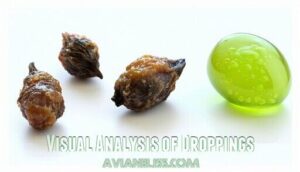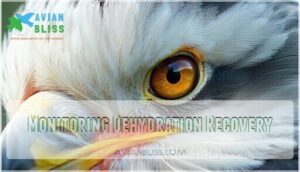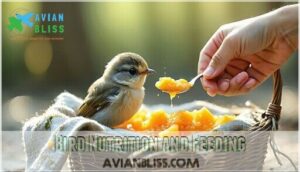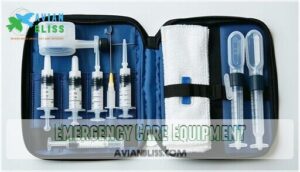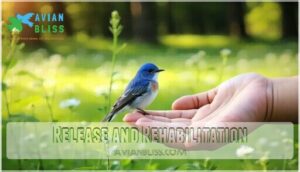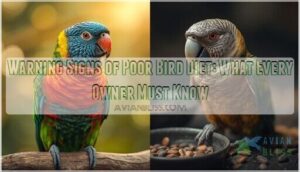This site is supported by our readers. We may earn a commission, at no cost to you, if you purchase through links.
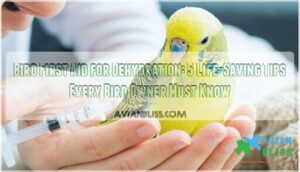
Look for dry droppings, sunken eyes, or a fluffed-up, lethargic bird—like your feathered friend just pulled an all-nighter.
First, offer clean, lukewarm water and, if needed, mix a homemade rehydration solution (warm water, honey, and a pinch of salt).
Use a syringe or spoon to gently drip it onto their beak if they’re not drinking.
Keep them warm—think cozy blanket, not sauna—and monitor closely for improvement.
If signs persist or worsen, seek help from an avian vet.
Remember, a little care can make a big difference!
Table Of Contents
- Key Takeaways
- Bird Dehydration Signs
- Rehydrating Dehydrated Birds
- Bird Nutrition and Feeding
- Emergency Care Equipment
- Release and Rehabilitation
- Frequently Asked Questions (FAQs)
- How do you rehydrate a bird?
- What first aid should be given for dehydration?
- Can I give Pedialyte to my bird?
- How can I protect my bird from dehydration?
- What are the ways to stop dehydration?
- What is bird dehydration?
- How do you feed a dehydrated baby bird?
- How do you treat a sick bird?
- How to cure dehydration in birds?
- How to hydrate an injured bird?
- Conclusion
Key Takeaways
- You’ll need to act quickly at the first signs of dehydration in birds, looking for dry droppings, sunken eyes, lethargy, and sticky mouth membranes since birds can become severely dehydrated within hours.
- You can make a homemade rehydration solution with warm water, honey or sugar, and a pinch of salt, administering it in small droplets using a clean syringe, artist brush, or dropper at the side of the bird’s beak.
- You should keep your dehydrated bird warm in a quiet, lined box while monitoring their recovery through improved droppings, increased alertness, and better skin elasticity before gradually reintroducing normal food.
- You’ll want to maintain proper hydration preventatively by providing fresh water daily, offering high-water content fruits, and keeping appropriate humidity levels in your bird’s environment.
Bird Dehydration Signs
You’ll need to recognize dehydration signs quickly to save your bird’s life, including sunken eyes, sticky mouth membranes, reduced skin elasticity, and unusual droppings.
Catching these symptoms early can mean the difference between a swift recovery and a medical emergency, so always monitor your feathered friend’s appearance and behavior for these critical warning signals, which are key to preventing a medical emergency.
Visual Analysis of Droppings
Examining your bird’s droppings provides critical insights into their hydration status.
Healthy droppings contain three components: feces (dark), urates (white), and urine (clear).
When birds become dehydrated, you’ll notice less moisture and more paste-like consistency.
The absence of the dark component suggests starvation, while bright green, bile-like substances indicate severe malnutrition.
Regular dropping color analysis can help you catch dehydration before it becomes life-threatening.
Monitoring droppings also allows for early detection of illness.
Identifying Nutritional Deficiencies
Nutritional red flags in your bird’s health reveal themselves through various indicators. Pay close attention to these warning signs:
- Dull, frayed feather quality with possible discoloration
- Abnormal beak growth or texture changes
- Significant or rapid weight loss without dietary changes
- Decreased energy levels and activity
Comprehensive dropping analysis can also indicate nutritional deficiencies by showing color variations or undigested food particles.
Proper avian nutrition requires vigilance, as birds often mask illness until severely compromised.
Recognizing Physical Symptoms
Watching for physical dehydration signs in your bird could save its life.
Look for sunken, dull eyes and wrinkled skin around eye areas.
Check skin elasticity by gently pinching featherless areas – it should spring back immediately.
Examine mucous membranes inside the mouth for stickiness or dryness.
Monitor body temperature; dehydrated birds often feel cooler than normal.
Remember that dropping analysis provides additional clues – absence of moisture indicates serious avian dehydration symptoms.
Rehydrating Dehydrated Birds
You’ll need to act quickly when your feathered friend shows signs of dehydration, as proper rehydration can mean the difference between life and death.
Using the right fluids and administration techniques, you can restore your bird’s hydration levels and help them recover from this dangerous condition.
Homemade Rehydration Fluids
When your feathered friend is dehydrated, a homemade rehydration solution can be a lifesaver.
Mix 8 oz of warm water with ½ tablespoon sugar and ⅛ teaspoon salt for an effective bird electrolyte solution. For alternatives, honey can replace sugar in small amounts.
You can also buy pre-made electrolyte solutions for birds.
Verify fluid temperature is lukewarm, as cold liquids can shock your bird’s system. Monitor salinity levels carefully—too much salt can worsen dehydration rather than help it.
Administering Rehydration Fluids
Now that you’ve prepared your homemade rehydration fluid, administering it properly is your next challenge. Fluid temperature and delivery methods are critical for successful bird fluid therapy.
When giving oral fluids to your dehydrated bird:
- Use a clean, slightly moistened artist brush to gently place drops inside the beak
- Administer with a 1ml insulin syringe, offering single droplets at a time
- Verify solution temperature matches the bird’s body temperature to prevent shock
Always calculate appropriate volume based on your bird’s size and condition. Many use a specialized artist brushes for this task, ensuring a successful bird fluid therapy.
Monitoring Dehydration Recovery
After giving your bird rehydration fluids, you’ll need to watch for recovery signs.
Check their droppings regularly—they should gradually return to normal consistency and color. Monitor hydration levels by observing behavior changes like increased alertness and activity.
Track fluid intake and weigh your bird daily if possible. Improved skin elasticity and brighter eyes are excellent indicators that your avian rehydration efforts are working.
Remember, consistent bird health monitoring is key to ensuring full recovery from dehydration, and it involves regular checks and maintaining a record of fluid intake.
Bird Nutrition and Feeding
You’ll need to carefully move your bird from rehydration fluids to proper nutrition once they’re stabilized.
After addressing dehydration, choose easily digestible foods appropriate for your bird’s species, gradually introducing solid options while monitoring their response.
Hand-Feeding Young Birds
Hand-feeding young birds requires delicate precision and patience, especially when dealing with dehydrated nestlings.
You’ll need to maintain proper crop management while administering nutrition using specialized feeding techniques.
- Use a clean syringe or spoon for formula preparation, warming to body temperature
- Administer food at a 45-degree angle to prevent aspiration
- Monitor the crop until it feels like a soft partially-filled water balloon
- Gradually introduce weaning strategies as birds develop
- Be mindful of imprinting concerns with baby birds during avian rehydration
Recommended Foods for Birds
When selecting foods for your recovering bird, prioritize options that support rehydration while meeting nutritional needs.
For severely dehydrated birds, start with easily digestible liquid foods like Critical Care Formula after initial rehydration.
Species-specific formulas are essential for raptors and seabirds.
You can offer soaked Purina GoCat chicken and duck biscuits as a suitable hand-feeding option for corvids.
Fruits with high water content like apples and watermelon help maintain hydration for other species.
Supplementing With Vitamins and Minerals
While quality bird food provides basic nutrition, vitamins and minerals play a critical role in recovery from dehydration.
Consider these supplements for ideal health:
- Poly-Aid Plus delivers vitamins, electrolytes and probiotics perfect for sick birds (once daily for smaller species)
- REVITALIZE replaces body salts and glucose energy during stressful events
- Zoo Meds Avian Plus contains a complete amino acid complex that enhances plumage
Always monitor for vitamin deficiencies and adjust mineral supplementation based on your bird’s specific needs to ensure ideal health.
Encouraging Self-Feeding
A bird’s return to self-feeding is a pivotal milestone in recovery from dehydration.
Place accessible dishes with food variety – including soaked biscuits, mealworms, and fruits – at comfortable heights. Natural supplements like cuttlefish bone support nutritional balance.
For gradual shift from hand-feeding, try leaving small amounts nearby while you’re present. Many birds overcome bird dehydration faster when they see others eating, making soft release setups ideal for rehabilitation.
A balanced diet should include essential nutrients for birds to support their recovery, focusing on a balanced diet.
Emergency Care Equipment
You’ll need a well-stocked emergency kit ready before your feathered friend faces a dehydration crisis.
Having the right tools on hand, such as syringes, dropper pipettes, and heating pads, can make the difference between life and death for your dehydrated bird, as it helps address the dehydration issue effectively.
Essential Supplies for Bird First Aid
Now that we’ve covered proper nutrition, let’s look at what belongs in your bird first aid kit. You’ll need warming devices like heat pads or hot water bottles, feeding tools such as syringes and soft brushes, and cleaning supplies for maintaining hygiene.
Don’t forget bird electrolyte solution for addressing dehydration emergencies. It’s also wise to research complete bird kits for convenience.
Keep restraint methods like soft towels handy to safely handle your stressed feathered friend during bird rehydration procedures.
Equipment for Handling and Examining Birds
Now that your first aid kit is stocked, you’ll need proper tools for safely handling and examining your feathered patient.
Gentle towel restraint provides control without causing stress—wrap small birds in a washcloth, larger ones in a hand towel.
Keep various syringe sizes (1-10ml) for fluid administration, a digital scale for accurate weight monitoring, a beak speculum for oral exams, and a magnifying glass to inspect tiny injuries during bird emergency care.
Creating a Safe and Warm Environment
Now that you have the right tools for examination, your next priority is creating a sanctuary for recovery. A safe, warm environment substantially reduces stress and boosts healing for dehydrated birds.
- Use a cardboard box sized appropriately for the bird’s wingspan
- Line with non-ripped towels to prevent entanglement
- Place a hot water bottle wrapped in cloth underneath for consistent warmth
- Maintain ambient temperature of 85-90°F initially
Remember, minimizing bird stress through proper safe bird handling techniques is just as important as addressing dehydration directly. You should also be ready to provide basic avian first aid while seeking professional veterinary care. This approach ensures a comprehensive response to the bird’s needs, focusing on both recovery and care.
Release and Rehabilitation
You’ll need to carefully assess your bird’s recovery before returning it to its normal environment, ensuring it can eat, drink, and maintain proper body temperature independently.
Once your feathered friend has fully rehydrated and regained strength, you can gradually reintroduce it to its regular habitat through a monitored phased introduction that prevents relapse, allowing for a successful recovery with proper rehydration.
Evaluating Release Readiness
Once your emergency kit is stocked, you’ll need to know when a rescued bird is ready to return to the wild.
Before releasing a rehabilitated bird, assess these key factors: Flight Strength (can it fly strongly without fatigue?), Health Assessment (clear eyes, normal droppings), Foraging Skills (ability to find food independently), Social Behavior with other birds, and Predator Avoidance instincts.
Understanding bird habitats by vegetation is also essential for ensuring the bird is released into a suitable environment.
Bird rehydration methods should have fully restored the bird’s natural alertness during avian recovery.
Soft Release Setup for Hand-Raised Birds
After rehabilitation, hand-raised birds need a carefully planned soft release to move back to the wild.
Create an outdoor flight cage with proper aviary design that includes covered retreats for safety.
Let your bird fly freely daily to build strength while monitoring behavior.
Diet change should happen once they’re self-feeding, and patience is key—some birds need just 3 days while others might take up to 50 for proper socialization strategies before release site selection.
Seeking Expert Assistance for Release
While hand-raised birds need specialized release environments, you’ll want to connect with licensed wildlife rehabilitators before any release attempts.
These experts can properly assess release criteria and guide you through legal considerations for different species. Your local avian veterinarian can recommend qualified rehabilitators who’ll guarantee proper post-release monitoring.
Remember, bird rehabilitation isn’t a DIY project—professionals have the training and permits required for successful movements to the wild.
Long-term care may be necessary for birds unable to survive independently.
Frequently Asked Questions (FAQs)
How do you rehydrate a bird?
Gently offer your bird a rehydration solution of 1 part sugar, 1 part salt, and 100 parts lukewarm water using a dropper. You’ll also want to provide fresh water in an accessible dish.
What first aid should be given for dehydration?
While your body craves water, your feathered friend needs urgent care too.
Offer lukewarm water mixed with a pinch of sugar and salt using a dropper or small brush, administering single droplets into their beak.
Can I give Pedialyte to my bird?
Yes, you can give your bird diluted Pedialyte as an emergency rehydration solution.
Mix it with equal parts water, make certain it’s at room temperature, and administer small drops using a syringe or dropper.
How can I protect my bird from dehydration?
Did you know tiny finches can become severely dehydrated within just 2-3 hours in hot weather?
Provide fresh water daily, offer hydrating fruits like cucumber or watermelon, and maintain proper humidity in your bird’s environment.
What are the ways to stop dehydration?
To stop dehydration, you’ll need to offer fluids regularly, monitor water intake, provide high-water content foods, and maintain proper environmental humidity.
During illness, use dropper-administered rehydration solutions like sugar-salt mixtures or commercial electrolyte products.
What is bird dehydration?
Bird dehydration occurs when your feathered friend loses more fluids than they take in.
You’ll notice sunken eyes, wrinkled skin around eye areas, sticky mouth membranes, and reduced skin elasticity when pinched.
How do you feed a dehydrated baby bird?
First rehydrate the baby bird with warm sugar-salt solution using a soft artist brush or dropper.
Offer tiny amounts at body temperature, ensuring the bird is warm before feeding to prevent digestive issues.
How do you treat a sick bird?
While panic fills the air, you must place your sick bird in a warm, quiet box lined with soft towels.
Keep it hydrated, contact a vet immediately, and don’t check too frequently, as this will help prevent panic.
How to cure dehydration in birds?
To cure dehydration in birds, offer warm fluids using a clean artist brush or dropper, giving single droplets at the beak’s side.
You’ll need a mix of water, sugar, and salt at body temperature.
How to hydrate an injured bird?
Like a desert wanderer seeking an oasis, your injured feathered friend needs gentle hydration.
Offer droplets of lukewarm sugar-salt solution (1 pinch each per cup) using a clean artist brush or eyedropper into their beak.
Conclusion
Like a vigilant guardian angel, your quick response with proper bird first aid for dehydration can mean the difference between life and death for your feathered companion.
You’re now equipped with the knowledge to recognize warning signs, administer fluids, and create a supportive environment during recovery.
Remember, these critical skills should become second nature—just like checking your bird’s food and water daily.
When in doubt, don’t hesitate to consult an avian veterinarian. Your bird’s life may depend on it, and this action can be the key to saving a life, making it a life and death decision.

